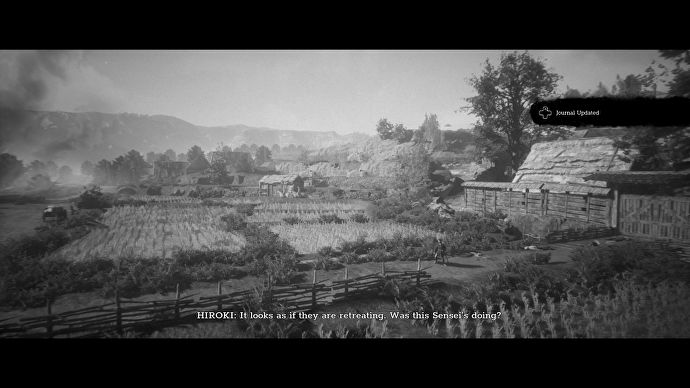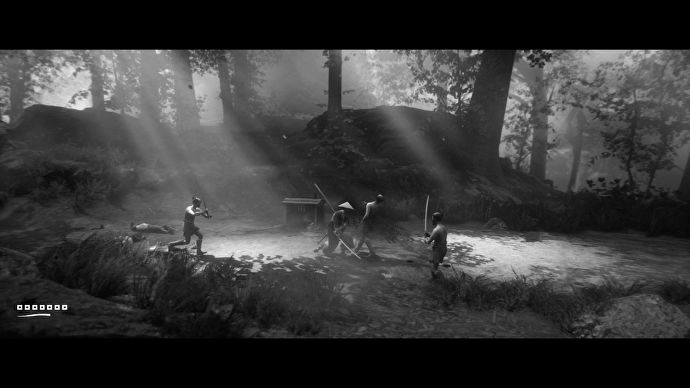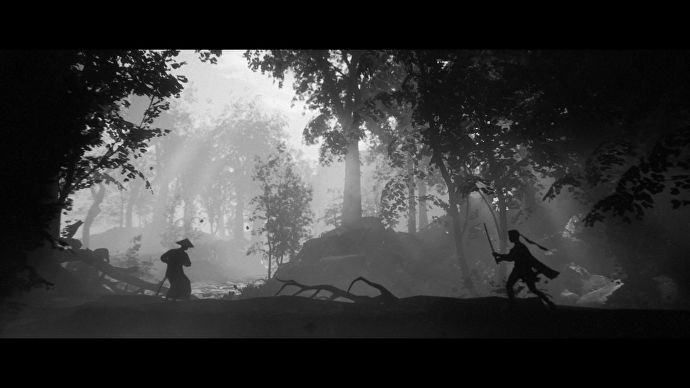Trek To Yomi is a samurai saga that oozes style and simplicity

From the small slice I’ve played of samurai slasher Trek To Yomi, I’m convinced it’s going to be the most Instagrammable game out there. Every frame looks gorgeous, capturing feudal Japan through a grainy black and white lens that evokes classic samurai flicks. Thankfully, there’s some substance to match this style too. Combat is elegant and the story seems refined, not bloated, which makes this a ronin romp worth watching out for.
Some old samurai dramas inch forwards, with long chats on tatami mats as messengers hurry in and bow and introduce yet another wisened warrior to the discussion. So far, at least, Trek To Yomi cuts to the chase—quite literally. In its first two chapters, you’re thrust into the geta of Hiroki, a young samurai who witnesses the death of his master and vows to protect his town from bandits.
The game’s opening chapter is a flashback to Hiroki in training with his master. A combat tutorial blends nicely into the origin story, as he teaches you basic sword combos like lightning-fast upward slashes and slower, stronger downward slices. Time your parries right and carve into the opening. Never face away from your opponent! Then suddenly the master is sprinting out of the dojo with a spear in his hands, and he tells you wait there – that’s an ORDER!
Naturally you disobey your master and go searching for him in town. And it’s here where Trek To Yomi blew me away with its presentation. It’s got this grainy black and white look, with camera angles that make you feel like you’re in one of those samurai films. As you move freely between market stalls and side streets, the camera nestles itself behind shopkeepers, so as you run by, you weave between their silhouettes. It pans out, allowing you to drink in the billowing fields of rice and the mountains rising in the distance. Every shot does its utmost to make your surroundings pop and I’m not exaggerating when I say it’s a genuinely beautiful game.

In these periods of exploration, you’re encouraged to take the odd diversion and see if there’s any loot glinting away. Most of the time you’ll find little collectibles in little rooms with interesting little descriptions, but curiosity really pays off when you find stamina or health upgrades. Don’t expect intricate maps with multiple paths, as there’s usually only one other option. But this is good! It means that the way forwards is always clear.
Later, as you grow up and into older Hiroki, seeking alternate paths might lead to some fun environmental hazards that’ll let you skip entire fight sequences. You know, you cut a rope and watch some big logs squash some dudes who were previously chatting smack over a campfire, things like that. This proves handy, seeing as duels can spell death in seconds.
Chapter two sees you tustle in a town besieged by bandits, as well as a mine they’ve repurposed as a hideout. Duels always see the camera turn side-scroller as enemies, katanas aloft, spring at you from the front or behind. Your job is to find openings by blocking or parrying, then fell them in a flash. As you can only take a number of hits and have a limited supply of stamina, the game’s challenge lies in holding your nerve enough to make it from one checkpoint to another in one piece.

While Trek To Yomi’s combat feels fun, I found the enemy variety to be a touch lacking early on. There are a lot of your regular ‘ol bandits that can be dealt with pretty swiftly, especially if you learn their attack patterns. Armored enemies offer a greater challenge, as they can withstand more hits. Otherwise, that’s your lot for two chapters.
I’m sure Trek To Yomi has more tricks up its sleeve, though. You unlock more combos and abilities as you progress, like one that lets you swing backwards with a slash, then follow up with two rapid strikes: perfect for dealing with any bandit backstabbers. Eventually, holding parry means you automatically face a striking enemy, which sounds simple but is totally transformative.
And the boss fights offered a glimpse into the game’s potential for more complex battles, like one spear-wielding marauder who called in reinforcements and prodded me into a corner with his pointy stick. I had to time my parries carefully, as openings weren’t in abundance, while making sure I didn’t lose a cheap health bar to his cronies.

Story beats with the spear guy were quick and concise, with the score settled almost. I’ll avoid spoilers here, but the twist arrives swiftly too. Early on, it seems like the game’s story has room to become more complex but it certainly doesn’t hang around. Again, I like that it’s aware of its limits and is keen to get you back into the action, rather than get hung up in cutscenes.
Trek To Yomi is a refined samurai slasher that shows great potential. There’s no bloat here, only a simple story backed by a gorgeous setting and refined combat. I’m keen to unsheathe my blade and get back in there – mainly so I can get some more nice screenshots.
Disclosure: RPS co-founder Alec Meer (RPS in peace) is the writer on Trek To Yomi.
Reference-www.rockpapershotgun.com